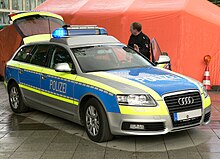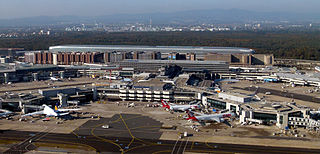
As a densely populated country in a central location in Europe and with a developed economy, Germany has a dense transport infrastructure.

Speed limits on road traffic, as used in most countries, set the legal maximum speed at which vehicles may travel on a given stretch of road. Speed limits are generally indicated on a traffic sign reflecting the maximum permitted speed, expressed as kilometres per hour (km/h) or miles per hour (mph) or both. Speed limits are commonly set by the legislative bodies of national or provincial governments and enforced by national or regional police and judicial authorities. Speed limits may also be variable, or in some places nonexistent, such as on most of the Autobahnen in Germany.
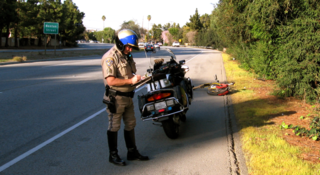
A highway patrol, or state patrol is either a police unit created primarily for the purpose of overseeing and enforcing traffic safety compliance on roads and highways, or a detail within an existing local or regional police agency that is primarily concerned with such duties. They are also referred to in many countries as traffic police, although in other countries this term is more commonly used to refer to foot officers on point duty who control traffic at junctions.

A dual carriageway (BrE) or a divided highway (AmE) is a class of highway with carriageways for traffic travelling in opposite directions separated by a central reservation (BrE) or median (AmE). Roads with two or more carriageways which are designed to higher standards with controlled access are generally classed as motorways, freeways, etc., rather than dual carriageways.

A limited-access road, known by various terms worldwide, including limited-access highway, dual-carriageway, expressway, and partial controlled-access highway, is a highway or arterial road for high-speed traffic which has many or most characteristics of a controlled-access highway, including limited or no access to adjacent property, some degree of separation of opposing traffic flow, use of grade separated interchanges to some extent, prohibition of slow modes of transport, such as bicycles, (draught) horses, or self-propelled agricultural machines; and very few or no intersecting cross-streets or level crossings. The degree of isolation from local traffic allowed varies between countries and regions. The precise definition of these terms varies by jurisdiction.
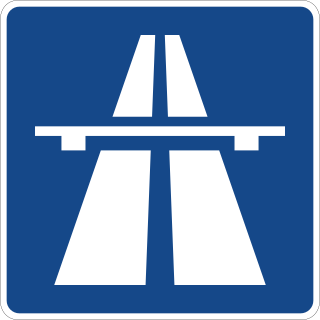
The Autobahn is the federal controlled-access highway system in Germany. The official German term is Bundesautobahn, which translates as 'federal motorway'. The literal meaning of the word Bundesautobahn is 'Federal Auto(mobile) Track'.

Traffic police are police officers and units who enforce traffic laws and manage traffic. Traffic police include police who patrol highways, direct traffic, and address traffic infractions. They may be a separate agency from a main police agency, a unit or division within a police agency, or a type of assignment issued to officers; they can also be part of a transportation authority or highway authority.

A controlled-access highway is a type of highway that has been designed for high-speed vehicular traffic, with all traffic flow—ingress and egress—regulated. Common English terms are freeway, motorway and expressway. Other similar terms include throughway and parkway. Some of these may be limited-access highways, although this term can also refer to a class of highways with somewhat less isolation from other traffic.

Alarm für Cobra 11 – Die Autobahnpolizei is a long-running, popular German television series about a two-man team of highway police (Autobahnpolizei), originally set in Berlin and since 1999 in the area of Cologne. The series has been broadcast in 120 countries worldwide.
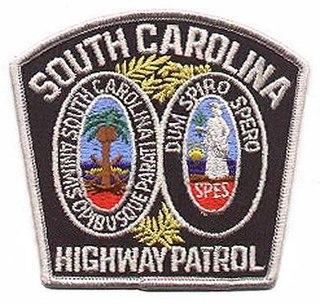
The South Carolina Highway Patrol is the highway patrol agency for South Carolina, which has jurisdiction anywhere in the state except for federal or military installations. The Highway Patrol was created in 1930 and is an organization with a rank structure similar to the armed forces. The mission of the South Carolina Highway Patrol includes enforcing the rules and regulations in order to ensure road way safety and reducing crime as outlined by South Carolina law. The Highway Patrol is the largest division of the South Carolina Department of Public Safety and its headquarters is located in Blythewood. This department also includes the South Carolina State Transport Police Division, and the South Carolina Bureau of Protective Services.
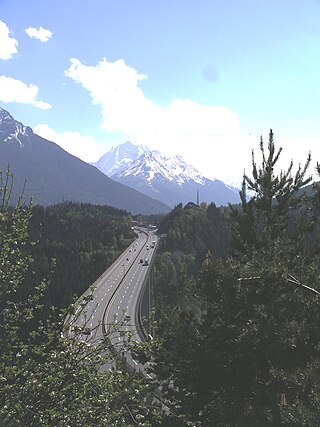
The Austrian autobahns are controlled-access highways in Austria. They are officially called Bundesstraßen A (Bundesautobahnen) under the authority of the Federal Government according to the Austrian Federal Road Act (Bundesstraßengesetz), not to be confused with the former Bundesstraßen highways maintained by the Austrian states since 2002.

An advisory speed limit is a speed recommendation by a governing body, used when it may be non-obvious to the driver that the safe speed is below the legal speed. It is a posting which either approximates the Basic Speed Law or rule or is based on a maximum g-force exerted at a specific speed. Advisory speed limits are often set in areas with many pedestrians, such as in city centres and outside schools, and on difficult stretches of roads, such as on tight corners or through roadworks. While travelling above the advisory speed limit is not illegal per se, it may be negligence per se and liability for any collisions that occur as a result of traveling above the limit can be placed partially or entirely on the person exceeding the advisory speed limit.

The Punjab Highway Patrol serves as the safe highways police for all Provincial Highways of Punjab. The PHP patrol the roads to maintain safe highways and prevent crimes from taking place, especially in rural regions of Punjab. Recently, in many districts, some of the patrolling units have also been given the responsibility for imposing tickets for traffic violations.

A speed limit is the limit of speed allowed by law for road vehicles, usually the maximum speed allowed. Occasionally, there is a minimum speed limit. Advisory speed limits also exist, which are recommended but not mandatory speeds. Speed limits are commonly set by the legislative bodies of national or local governments.

Road signs in Thailand are standardized road signs similar to those used in other nations but much of it resembles road signage systems used in South American countries with certain differences, such as using a blue circle instead of a red-bordered white circle to indicate mandatory actions. Until the early 1980s, Thailand closely followed American, European, Australian, and Japanese practices in road sign design, with diamond-shaped warning signs and circular restrictive signs to regulate traffic. For Romanized, signs usually use the FHWA Series fonts typeface, which is also used on American road signage, but for Thai text, the font used is unknown.

Crash Time: Autobahn Pursuit is a mission-based driving game released for the PC in 2007 and Xbox 360 in 2008, and a sequel to Alarm für Cobra 11: Nitro. It is based on the German television series Alarm für Cobra 11 – Die Autobahnpolizei, and features several characters from the show working their way through criminal cases set in fictitious versions of the city streets of Cologne, and the autobahn in North Rhine Westphalia. The developers created a "Pathfinder" to ensure that the AI vehicles do not always follow the same path during a pursuit. It was not received well by critics, with graphics and plot being of concern. Four sequels have been released on Xbox 360 and through online content provider Steam.
This article describes the highway systems available in selected countries.

Speed limits are enforced on most public roadways by authorities, with the purpose to improve driver compliance with speed limits. Methods used include roadside speed traps set up and operated by the police and automated roadside 'speed camera' systems, which may incorporate the use of an automatic number plate recognition system. Traditionally, police officers used stopwatches to measure the time taken for a vehicle to cover a known distance. More recently, radar guns and automated in-vehicle systems have come into use.

Speed limits in Germany are set by the federal government. All limits are multiples of 10 km/h. There are two default speed limits: 50 km/h (31 mph) inside built-up areas and 100 km/h (62 mph) outside built-up areas. While parts of the autobahns and many other freeway-style highways have posted limits up to 130 km/h (81 mph) based on accident experience, congestion and other factors, many rural sections have no general speed limit. The Road Traffic Regulations (StVO) section on speed begins with the requirement which may be rendered in English:
Any person driving a vehicle may only drive so fast that the car is under control. Speeds must be adapted to the road, traffic, visibility and weather conditions as well as the personal skills and characteristics of the vehicle and load.
Traffic signs, installations, and symbols used in Germany are prescribed by the Road Traffic Regulations (StVO) and the Traffic Signs Catalog (VzKat).
